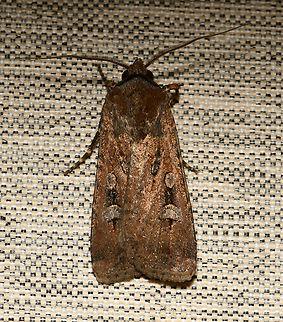
Appearance
Adult bogong moths have an overall dark brown colouration, with a dark stripe interrupted by two light-coloured spots on the wings, distinguishing it from other moths. There are visual differences between the migratory and nonmigratory forms of the moth; migratory moths have brown hind wings while nonmigratory moths have paler hind wings. Bogong moths have a wingspan ranging between 40–50 mm, and a body length of around 25–35 mm. The average weight of an adult bogong moth is 0.326 grams.Bogong moth eggs are dome–shaped in appearance and are vertically ridged. They are 0.7 mm in diameter and 0.4 mm in height.
Caterpillars initially start out with a pale colouration, but as they grow and consume food they become green with pale and dark stripes and spots. Larvae achieve a maximum length of 50 mm.
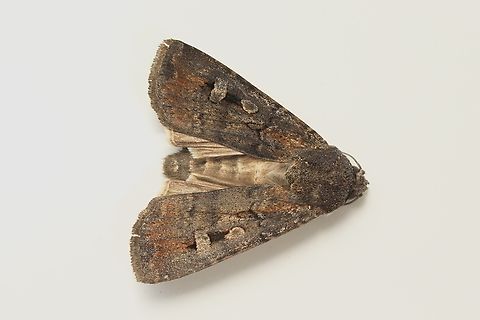
Naming
Bogong moths was first described by French lepidopterist Jean Baptiste Boisduval in 1832, who described the moth as "Noctua infusa" from a type specimen from Australia. He described the moth as having blackish-brown hind wings. However, in 1903 British entomologist George Hampson classified a specimen with white hind wings under this name, alongside another specimen of "Agrotis spina" with blackish-brown hind wings. Australian amateur entomologist Alfred Jefferis Turner identified "A. spina" as a synonym of "A. infusa" in 1920. I. F. B. Common, an Australian entomologist, found specimens with both hind wing colours in 1954. Specimens with the white hind wings were only found during specific months in mercury vapour light traps near Canberra, and he attributed the white hind wing specimens to a seasonal form.The moth's name, "bogong", is derived from the Dhudhuroa word "bugung", meaning brown moth. Its presence has contributed to the naming of numerous locations and landmarks. For example, a town, Bogong, in the Australian state of Victoria has been named after the moth. Mount Bogong, located south of the Bogong High Plains, is also named after the moth, with its traditional name, "Warkwoolowler", meaning the mountain where Aboriginal people collected the "boo.gong fly". The Taungurung name for the bogong moth is "debera".
In the Australian state of New South Wales, a series of mountains in the Kosciuszko National Park are named the Bogong Peaks.
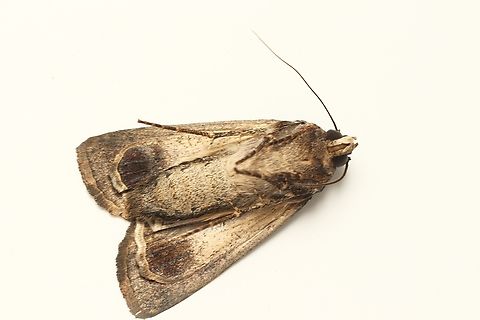
Distribution
Bogong moth populations are primarily located across southern Australia, west of the Great Dividing Range. The regions contain populations of nonmigratory and migratory moths of this species, distinguished by their differing seasonal presences in each region. The adult bogong moth lays eggs across New South Wales, southern Queensland, and northern parts of Victoria, where larvae hatch and grow until adulthood. During the spring season and subsequent summer aestivation, bogong moths migrate south or east towards the Australian Alps, and can be found in the Australian Capital Territory and Bogong Mountains. However, bogong moths can also be found in locations as far as Tasmania and New Zealand due to strong winds that blow them off their path.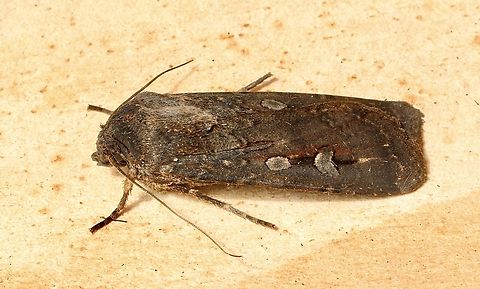
Status
In December 2021 the bogong moth was added to the IUCN Red List as an Endangered Species, based on a February 2021 assessment.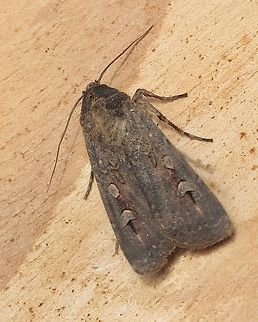
Behavior
Adult bogong moths lay up to 2000 eggs in the soil or on plants near the soil after returning from aestivation sites in the autumn migration. Incubation times vary depending on temperature, with eggs hatching after a period of 4–7 days in laboratory conditions. The larvae of bogong moths undergo six instars. Caterpillars grow slowly throughout the first three instars, taking until June to develop over the winter. However, the larvae go through fast growth during the spring, reaching the final instar in late August to September, soon before migration. They are active at night, when they feed on plants within breeding grounds. Larvae undergo pupation in soil chambers at a depth of 20–150 mm. Pupation can last between 3–11 weeks depending on the temperature and environment. Pupae are 20 mm in length and have a shiny, brown appearance. Adults emerge from the soil chambers and shortly after begin migration. Adult bogong moths are active at night, and have different seasonal behaviors. During the spring, bogong moths feed and migrate south, where they aestivate during the summer. Adult bogong moths are not sexually mature yet, and do not actively seek food during this period of dormancy. In autumn, the moths migrate again and return to their breeding grounds, laying eggs and dying.During the spring migration, bogong moths gregariously aggregate with densities reaching 17,000 moths per square metre within caves, crevices, and other areas hidden from the sunlight. The lack of light and relatively constant temperature and humidity makes these spots favourable during aestivation. The first moths that arrive occupy the deepest and darkest locations, using their fore tarsi to grip onto the rock faces, and aggregations form around these initial areas, with moths arriving later settling for less ideal areas with more sunlight, higher temperatures, and decreased humidity. To diminish the amount of light that reaches their light-sensitive eyes, later moths push themselves underneath the wings and abdomens of moths that arrived earlier and place their hind legs on top of the moths beneath them. This physical contact and aggregation allow the moths to retain body moisture. When the aestivating moths are disturbed, the moths within the area of disturbance briefly spread out and leave the aggregation, dropping excrement when unsettled before quickly returning to the aggregation and re-positioning themselves.While the moths mostly remain dormant during aestivation, there are some periods of activity within the aggregation which are correlated to changes in light intensity. During dawn and dusk, portions of the population become active, first crawling around and spreading out, and then flying out of their shelter into the open. While some water drinking has been observed, no evidence of copulation or active foraging has been found during these periods of activity.
Habitat
Bogong moth populations are primarily located across southern Australia, west of the Great Dividing Range. The regions contain populations of nonmigratory and migratory moths of this species, distinguished by their differing seasonal presences in each region. The adult bogong moth lays eggs across New South Wales, southern Queensland, and northern parts of Victoria, where larvae hatch and grow until adulthood. During the spring season and subsequent summer aestivation, bogong moths migrate south or east towards the Australian Alps, and can be found in the Australian Capital Territory and Bogong Mountains. However, bogong moths can also be found in locations as far as Tasmania and New Zealand due to strong winds that blow them off their path.Reproduction
Bogong moth eggs and larvae are primarily found in self-mulching soils and crop pastures, where both wild and agricultural larval food sources are abundant during the autumn and winter seasons. The heavy presence of larvae in these pastures can lead to significant crop damage. During the spring and summer seasons, when grasses overtake these pastures, conditions are unfavourable for larval survival since larvae do not consume these plants. This leads to delayed breeding, as bogong moths are multivoltine and so can raise multiple generations. Instead, adult bogong moths migrate in a southerly direction during the summer and aestivate, until conditions are favourable again.Food
Bogong moth larvae subsist on winter pasture crops and wild crop weeds such as cape weeds within bogong moth breeding grounds, primarily depending on annual dicotyledons that grow during the winter. Attacks on a wide variety of cultivated crops have been seen, with plants such as "Medicago" species, wheat, cabbages, cauliflowers, silver beet, peas, and potatoes all recorded being consumed by bogong moth caterpillars. However, the larvae avoid grasses, which overtake pastures during the summer, making summer unfavourable due to lack of larval food sources. Adult bogong moths feed on the nectar of flowers such as "Epacris", "Grevillea" and "Eucalyptus" while breeding or migrating, but will not actively feed during aestivation.Bogong moths were historically used as a food source by Aboriginal peoples located in South-eastern Australia. Groups would travel to the area towards the summits of mountains to harvest moths, where they also met with other Aboriginal peoples, fostering inter-tribal relations as people gathered and feasted during these harvests. They would go into the caves and scrape aestivating moths off the walls into nets and dishes using sticks. Once gathered, the moths would be roasted to remove the scales and wings and then either eaten immediately or ground into a paste and made into "moth meat" cakes that would last and could be taken home. The moth was said to have a nice nutty flavour that was most similar to walnuts or almonds. The bogong moth is an icon of Australian wildlife due to this historical role as an important food source and as an inter-tribal gathering point in Southeastern Australia.An excavation of Cloggs Cave, near Buchan in Victoria, revealed microscopic remains of moth on a small grinding stone, estimated to be about 2,000 years old. This is the first confirmed evidence of insect food remains discovered on a stone artefact in the whole world. The Gunaikurnai people were one of the peoples who used to travel to the mountains to obtain the high-fat, energy-rich food, and stories of these travels had been passed down in their oral history. The excavation was done by researchers from Monash University in collaboration with the traditional owners, represented by the Gunaikurnai Land and Waters Corporation.
Predators
The bogong moth suffers from predation during both its migration and aestivation. During the spring and autumn migrations, several species of birds, mammals, and even fish have been recorded preying on the moth. Little raven, currawong and Australian pipit congregations form to feast on bogong moths as they travel from aestivation sites during migration. Aboriginal people also travelled to aestivation sites to feast on the dormant moths, and may have searched for these bird congregations to locate these sites. Bats also attack the moths during active flight periods during the dusk, and foxes, bush rats, and dusky antechinus have been recorded eating moths. Of the mammals that prey on the bogong moth, the endangered mountain pygmy-possum is the most reliant on bogong moths as a source of food.Migration
Bogong moths undergo whole scale long-distance migration biannually, in which they can travel up to 965 km. The spring migration begins in early September and occurs from the lowlands of Southern Australia south towards the Australian Alps for purposes of reaching aestivation sites. During the summer, the moths remain in their aestivation sites until autumn, when they migrate back towards the breeding grounds of the lowlands as early as February, but primarily in April. The bogong moth utilises particular aestivation sites repeatedly throughout migrations, as seen with the development of parasites that depend on the regular arrival and departure of the moths from caves. The population within each aestivation site fluctuates throughout the summer due to moth mortality and the departure and arrival of moths either migrating further south for aestivation or north to return to breeding grounds. However, this differs from changes during migration periods, when the populations rapidly increase with arrival or decrease with departure.Bogong moths are nocturnal migrants, but the exact mechanism for long-distance navigation is not clear. It is possible that they are oriented by light, as seen in the influence of light intensity on activity during aestivation. Additionally, bogong moths may use an internal magnetic compass to aid in navigation, as seen in the similar monarch butterfly. A study published in 2018 concluded that the Bogong moth uses a combination of the Earth's magnetic field and recognisable landmarks to calibrate their route. In 2025, researchers found that neurons in these insects responded to a starry sky, and suggested Bogong moths use both magnetic fields and stars to orient themselves and navigate.
However, there are also nonmigratory populations; this generally occurs in areas with favourable conditions, where migration to avoid harsh conditions such as seasonal changes in larval food crop abundance is not necessary. Some populations of bogong moths in areas such as Tasmania and in coastal populations of New South Wales do not migrate, and reach sexual maturity at a faster rate than migratory populations.Millions of bogong moths have been blown off course from their spring migration into major cities like Canberra, Melbourne, and Sydney due to strong winds, with notable instances of Bogong Moth invasions including the 2000 Olympics in Sydney. The large amount of light and noise present can also attract moths towards cities. Parliament House in Canberra, present in the middle of the Bogong Moth flight path during migrations, was notably susceptible to moths. Light pollution from the building traps them during their flight and encourages the moth to find shelter within crevices, shadows, and sometimes even the insides of the buildings during the light and heat of the day. Efforts have been made to try and drive the moths out by turning off lights, covering attractive corners and pathways indoors, and using insecticides. However, insecticide use has ceased in urban areas due to concerns over environmental consequences.
References:
Some text fragments are auto parsed from Wikipedia.